Cruisers project 68-bis
Lead - "Chapaev" - became part of the Navy in the autumn of 1949. Soon the fleet and the rest were taken. Simultaneously with the completion of the ships of the pre-war projects, scientific and practical work was continued on these years to create new generation warships, in which even the experience of war and everything new that post-war science and production could provide were taken into account. In part, they tried to take this into account in the new cruiser of the project 68bis, which was considered the second series of cruisers 68K.
A.S. Savichev became the chief designer of this ship, and the captain of 1 rank D.I. Kushchev became the main observer from the Navy.
Compared with its prototype (68K), it was distinguished by a fully welded body, an extended forecastle and a reinforced anti-aircraft weaponry. Strengthening weapons and protection, improved habitability, increased autonomy (30 days) and cruising range (up to 9000 miles) resulted in an increase in the total displacement to almost 17 000 tons.
To protect the vital parts of the ship in battle, traditional booking was used: counter-missile for the citadel, towers of the main caliber and the conning tower; ballistic and bulletproof - combat posts of the upper deck and superstructures. Used mainly homogeneous armor. For the first time the welding of thick ship armor was mastered, while she herself was fully integrated into the ship's structures.
The thickness of the armor used in these constructions was: onboard - 100-mm, bow-beam - 120-mm, stern -100-mm, lower deck - 50-mm.
Constructive underwater protection against torpedo and mine weapons The enemy included, in addition to the traditional double bottom, a system of side compartments (for storing liquid cargo) and longitudinal bulkheads. The location of the service and residential premises practically differed little from that taken on cruisers, 68K.
As the main caliber on ships pr. 68bis, four advanced three-gun artillery systems MK-5-bis (gun B-38) were used.
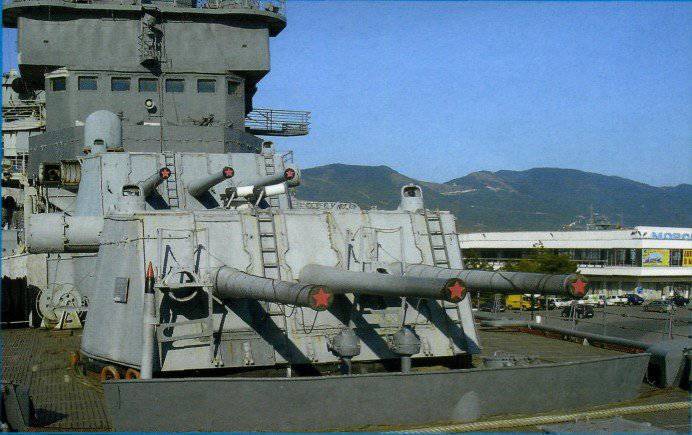
At the end of 50-s, the control system was finalized, which allowed firing the main caliber at aerial targets, using the control system of the universal cruiser caliber.
The universal caliber was represented by six paired stabilized installations CM-5-1 (later installed CM-5-1bis).
Anti-aircraft guns are represented by sixteen B-11 machines (later installed B-11М).
An important feature of the cruisers of this project is the presence of special artillery radar stations in addition to the optical means of targeting guns at the target. The effective combat use of main-caliber artillery was provided by the Lightning AC-68bis A shooting system. The mine-torpedo armament of the ships included two 533-mm five-pipe protruding deck torpedo tubes installed at the spardek, and their control system PUTS “Stalingrad-2T-68bis”, coupled with a special torpedo radar station. On deck, the cruiser of this project could take over 100 shipboard mine mines. Ships of this type were also equipped with modern for that time navigation and radio equipment, communications.
The ship power plant of the 68bis cruisers in general did not differ from the power plant of the ships of the 68K. True, several managed to increase the power at full speed, bringing it to 118100 HP.
Giving a general assessment of the ship, it can be noted that he was not the best representative of his class. According to its main characteristics, it was inferior to ships built during WWII. So, surpassing the US Navy lightweight cruiser “Cleveland” in the ultimate range of 152-mm guns, the 68bis was booked worse than 1.5, especially on the deck, which is essential when conducting combat at long distances. Our ship couldn’t actually carry out effective fire from 152-mm guns due to the lack of necessary control systems, and at smaller distances the Kpivland-type cruiser had the superiority (152-mm guns were faster, the number of universal 127-mm more guns - 8 on one side against our 6 guns (100-mm). Obsolete at the beginning of the 50's. The power plant of the 68bis cruiser with low steam parameters and boilers with fan blast to the boiler rooms, led to an increase in displacement 1.3 times compared to Cleveland (with the same cruising range). A major drawback of the entire national medium-caliber artillery was the fact that with separate loading of guns with 120-180-mm caliber they used cartridges without shells. This made it possible to shoot, if necessary, with incomplete charges (shooting at the shore or unprotected targets at small and medium distances), increasing the survivability of the guns, but did not make it possible to simplify loading and, consequently, increase the rate of fire.
In addition, the use of sleeves is always safer compared to a purely cranky charging.
In fact, the cruiser pr. 68bis fully responded to the purpose of the first post-war shipbuilding program - revitalizing the shipbuilding industry and educating seafarers. The main purpose of this ship was to protect battleships and heavy cruisers from attacks by destroyers, cover attacks from destroyers and torpedo boats, fire work on the shore, as well as independent actions on enemy communications.
The head cruiser pr.68bis, called "Sverdlov", was laid at the Baltic shipyard 15 in October 1949, launched on July 5 1950 and entered into service 15 in May 1952 (only 6 units were built at this factory). 11 - 18.06.1953. Sverdlov took part in the international naval parade on Portsmouth's Spithead raid on the occasion of the coronation of the British Queen Elizabeth II, where his crew demonstrated excellent maritime proficiency. All crew members were awarded a special commemorative badge, which depicted the silhouette of the cruiser Sverdlov. 12 — 17.10.1955 — a return visit to Portsmouth. 20 - 25.07.1956 paid a visit to Rotterdam (Holland), and after the re-activation of 5 - 9.10.1973, to Gdynia (Poland). 17 - 22.04.1974, a detachment of Soviet ships (the cruiser "Sverdlov", the destroyer "Resourceful" and a submarine) under the command of Rear Admiral V.I. Akimov made an official friendly visit to Algeria. 21 — 26.06.1974 paid a visit to Cherbourg (France); 27.06-1.07.1975 - in Gdynia;
5-9.10.1976 - in Rostock (GDR) and 21-26.06.1976 - in Bordeaux (France). In total, during the service, the Sverdlov passed 206 570 miles in 13 140 running hours.
The construction of these cruisers was also deployed at the Admiralty Shipyard (3 units), Sevmash (2 units) and the Black Sea Shipyard (3 units). By the 1955 year of the planned 25 units, it was possible to build only 14 cruisers of this project, which after the decommissioning of the old battleships became the largest ships in the Navy.
The hasty, not thought-out innovations of N.S. Khrushchev and his close associates affected in the most negative way the fate of these ships. So almost completely finished ships were cut into scrap. In addition to the last two, ship readiness ranged from 68 to 84%, and Kronstadt even went through mooring trials. The cruisers, put into operation, fate has developed in different ways. KR "Ordzhonikidze" 10-14.07.1954. paid a visit to Helsinki (Finland). 18 - The 27.04.1956 was a detachment of Soviet ships (KR “Ordzhonikidze”, EM “Looking” and “Perfect”) under the flag of Rear Admiral V.F. Kotov delivered to Portsmouth (Great Britain) a Soviet government delegation. It is curious that the admiral's salon was taken by N. S. Khrushchev, and N. A. Bulganin - by the commander. 20 April, the Soviet delegation visited a dinner at the Royal Maritime College in Greenwich. During the stay the sailors noticed an underwater saboteur at the side of the cruiser - he appeared for a moment and disappeared again. After some time, the body of a swimmer in a black diving suit emerged at the Ordzhonikidze site. English newspapers claimed that the corpse was without a head, which was never found. The swimmer was the captain of the 3 rank Lionel Crabb. Lieutenant Crabb was still in the 1941 year, joined the group of English combat swimmers based in Gibraltar. English newspapers wrote that he had begun his "studies" during the first visit to the UK of the cruiser Sverdlov. Then everything ended well. Then, British intelligence began to hunt for Ordzhonikidze. In 1955, in the Baltic Sea, a super-submarine belonging to the special services of the United Kingdom disappeared without a trace, trying to penetrate the cruiser's home base. 1 - 8.08.1956
Ordzhonikidze paid a visit to Copenhagen (Denmark); 7 - 11.08.1958 - in Helsinki. Since 14.02.1961 was part of the Black Sea Fleet. 5.04.1962 went from Sevastopol for the transfer of the Indonesian Navy and 5.08.1962 arrived in Surabaya. Subsequently, under the name "Irian" was part of the Indonesian Navy. After the coup, arranged by General Suharto, the cruiser was sent to prison for the Communists. In 1972, Irian is disarmed and sold for scrap.
"Admiral Nakhimov" (scheduled for rearmament on 71 Ave. with the installation of air defense missile systems), was excluded from the fleet in the 60s after participating in testing the first RCC samples.
"Dzerzhinsky" was retooled in accordance with pr. 70E (one tower of the main caliber was removed and in its place the Volkhov-M SAM system with ammunition in 10 anti-aircraft missiles was installed).
The M-2 complex was intended for the air defense of a ship against attacking bomber and missile aircraft. The M-2 anti-aircraft missile B-753 of the Volkhov C-75 complex was used as a fire weapon.
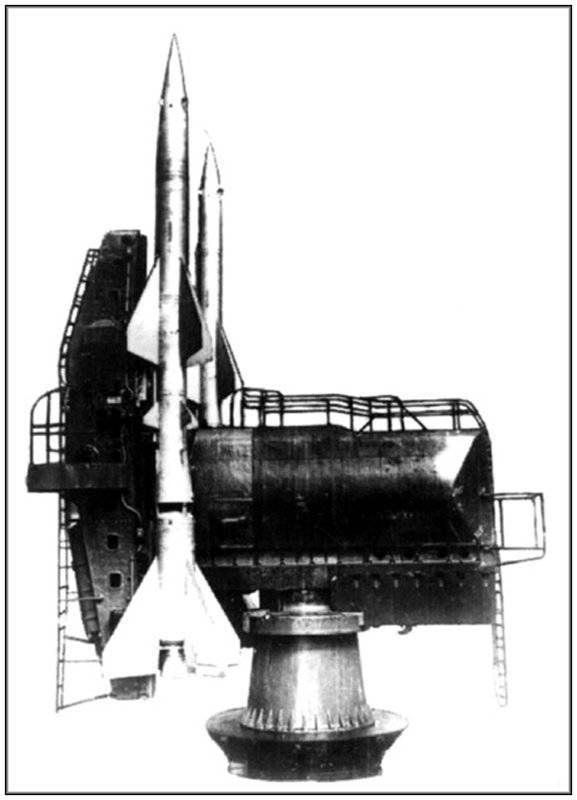
The rocket was a two-stage rocket B-750, modified for use in ship conditions, which was developed for the C-75 air defense missile system and was already tested in the middle of 1955. The range of the first shipboard SAM was to be 29 km, altitude from 3 to 22 km. To arm the ships on the rockets, the suspension units to the guides of the launcher had to be changed, and a number of construction materials were replaced, taking into account their use in marine conditions.
Due to the large dimensions of the missiles (their length was almost 10,8 m, and the span of the stabilizers was 1,8 m), the dimensions of the ship’s reconstructed artillery cellars were insufficient for them, with the result that the Dzerzhinsky had to make a special superstructure (cellar) 3,3 meters high, cut through the lower and upper decks, as well as the deck of the forecastle above it. The roof and walls of the cellar above the lower deck were armored with anti-bullet armor 20 mm thick. Of the ten missiles located in the cellar, eight were stored on two special rotating drums (four missiles each), two missiles were outside the drums and were intended to feed them.
In the cellar was placed equipment supply systems and loading rockets. The engine room of the cellar, located in its lower part, was separated by an "impermeable flooring".
One set of control and guidance systems “Corvette-Sevan”, radar for detecting air targets “Kaktus”, 2 set of identification equipment “Torch-M”, radar “Spill” (was installed later).
In its final form, the Dzerzhinsky KRL under the 70 project was presented for testing at the end of 1958, the mooring lines were carried out in October, the ship’s factory running tests were carried out in October, and the M-2 complex experimental design began in December. According to the program of these tests, the first D-753 missile launches were conducted with the Dzerzhinsky, which showed the performance of the launcher and missile feeders from the cellar, as well as safety for the ship superstructures of the impact of the missile launch accelerator system. Sevan "when shooting at targets towed by airplanes.
During the 1959 of the year, about 20 missile launches were carried out, including at air targets. The first real target for the M-2 was the Il-28 bomber, flying at an altitude of 10 km and which was shot down by the very first missile. However, in the process of creating M-2, it was not possible to implement all the solutions planned by the designers. So, in spite of the attempts made to create an automatic fueling system for the marching stage of rockets with fuel, in the final version it was decided to stop at their manual refueling in the rocket cellar before being sent to the launcher.
Following the results of its work, the State Commission made the following conclusion: “The M-2 anti-aircraft guided missile system, consisting of the Corvette-Sevan system, B-753 anti-aircraft missiles and the launch vehicle with the CM-64 charging and loading device, is effective an air defense weapon and can be recommended for arming naval ships as a military weapon with high accuracy in hitting air targets. "
At the same time, the commission indicated the need for additional work on the ship. In particular, it was necessary to ensure the protection of open battle posts of the cruiser from the gas jet of launching missiles, to develop and install an automatic fire extinguishing system in the ZUR cellar, to create and install on the ship a system for high-speed refueling of missiles with fuel in the process of supplying them from the storage to the PU.
The results obtained during the M-2 tests in 1959-60 were mostly close to the specified requirements. But a number of shortcomings of the new weapons were not ignored, and, first of all, the fact that the M-2 turned out to be too heavy and large in size, even for such a ship as the Dzerzhinsky. Another factor limiting the capabilities of the complex was the low rate of fire due to the considerable time required for reloading launchers, as well as a small amount of missile ammunition. In addition, the two-component, highly toxic fuel used at the missile defense system created an increased fire and explosion hazard.
However, given the experimental nature of the creation of the first ship-borne air defense missile system, these shortcomings did not belong to the critical category, and the ship equipped with this complex could easily be used as a floating "party", where it acquired its first experience with the calculations of future ship-borne air defense missile systems.
August 3 1961, after the completion of the test program M-2, "Dzerzhinsky" was transferred to the category of training ships. In this role, he performed several dozen long-distance hikes to Constanza (Romania), Varna (Bulgaria), Istanbul (Turkey), Lattakia (Syria), Port Said (Egypt), Piraeus (Greece), Le Havre (France) and Tunisia .
In the summer of 1967 and in the fall of 1973 of the year, while in the Mediterranean in the zone of military operations, Dzerzhinsky performed the task of assisting the armed forces of Egypt. The last test of the missile defense system on the ship was carried out in 1982 .. all missiles flowed and were not capable.
The explosion of the tower on the cruiser "Admiral Senyavin".
13 June 1978 of the year Admiral Senyavin KRU conducted training shooting. The fire led only one tower (No. I), the second was conserved and did not have personnel. Practical projectiles (that is, without explosives) and low-combat charges were used. After eight successful salvoes, on the ninth, the right gun did not fire.
Such a case was provided for, and two locks automatically turned on, preventing the shutter from opening. However, the calculation turned off the lock, opened the shutter, and the tray with the next charge was set to the loading position. As a result of the automatic activation of the drive, the sucker poured a new projectile into the weapon's chambers, crushing the charge in it, and it ignited. A jet of hot gases through the gap between the dispatched projectile and the tool chamber broke through into the fighting compartment. The old projectile flew out of the barrel and fell into the water in 50 m from the ship, and the new projectile flew back into the fighting compartment. A fire broke out in the tower. By order of the captain of the ship 2 rank V. Plakhov, the cellars of the I and II towers were flooded. The fire was extinguished by regular fire extinguishing equipment, but everyone who was in the first tower, including the correspondent of the “Krasnaya Zvezda” newspaper, captain of 2 rank L. Klimchenko, died. Of the 37 dead, 31 people were poisoned by carbon monoxide, three were drowned when the cellars were flooded, and three were fatal injuries.
The appearance of control ships in the USA and the unresolved nature of this problem in our fleet at the end of the 60s led to the conversion of two cruisers "Zhdanov" and "Admiral Senyavin" into control ships on 68У-1, 68У-2 avenue. Moreover, they were originally supposed to re-equip them at pr. 68U, but at the Vladivostok Dalzavod, not one tower of the main caliber was removed by mistake, but two. To hide this fact, two variants of the 68Y-1 and 68Y-2 projects were developed retroactively. Moreover, to use additional free weights and spaces on the 68-2, it was decided to place a helipad and a hangar for storing the Ka-25 helicopter.
In the 70-x on the 4-x ships additionally installed new 30-mm assault rifles AK-630 and ADMS Osa-M. Re-equipment and equipment of the ships and more modern radio engineering means were made.
On this ship, the development of a class of artillery cruisers in the Soviet Navy stopped, although the development of missile-artillery cruisers (variants with guns from 152-mm to 305-mm caliber, full armor and various missiles were considered) went up to 1991.
Cruisers pr. 68-bis
1. Cr. Sverdlov entered service on 1952, decommissioned on 1989 (37 years)
2. Cr. “Zhdanov” set foot on 1952, decommissioned on 1990 (38 years)
Converted to KU.
3. Kr. "Ordzhonikidze" was put into operation 1952 g., Decommissioned 1963 g. (11 years) Transferred to Indonesia.
4. Cr. "Dzerzhinsky" entered into service 1952, decommissioned 1988 (36 years) Converted to pr. 70-E.
5. Cr. "Alexander Nevsky" was put into operation on 1952, written off by 1989 (37let).
6. Cr. "Alexander Suvorov" "entered into service 1953, written off 1989, (36 years) Transferred from BF to Pacific Fleet.
7. Cr. "Admiral Lazarev" entered into operation 1953g., Decommissioned 1986 (33). Transferred from BF to Pacific Fleet.
8. Cr. "Admiral Ushakov" "entered into service 1953 g., Decommissioned 1987 g. (34 of the year). Transferred from BF to SF.
9. Cr. "Admiral Nakhimov" entered into operation 1953g., Decommissioned 1961 g. (11 years)
Dismantled after conversion.
10. Cr. "Molotovsk" entered into operation 1954., Decommissioned 1989 (35 years)
Renamed to "October Revolution"
11. Cr. "Admiral Senyavin" entered into operation 1954g., Decommissioned 1989 g. (35 years) Converted to KU.
12. Cr. "Dmitry Pozharsky" entered into service 1954, decommissioned 1987 (33). Transferred from BF to Pacific Fleet.
13. Cr. "Mikhail Kutuzov" entered into operation 1954g., Decommissioned 2002 g. (48 years). Turned into a museum of the Navy. Currently Kr. "Mikhail Kutuzov" is "on the eternal parking" as a ship-museum in Novorossiysk
14. Cr. "Murmansk" entered into service 1955, decommissioned 1992 (37 years)
The fate of the Kyrgyz Republic "Murmansk" was more tragic.
On his last cruise, the cruiser sailed under tugs, at the end of the 1994 of the year. It had to be cut up for scrap in India, where it was sold.
However, during a storm, after a break of towing cables, it was thrown into a shallow, off the coast of Norway, on a shallow, not far from the entrance to one of the fjords.
For a long time this giant, this pride of the Soviet Navy, rested at the Norwegian coast, at Cape North Cape, as if inquiring with its appearance: “Why did you do this to me?”.
In 2009, the Norwegian government decided to remove the wreck. The work turned out to be quite difficult and was repeatedly delayed.
Today, the operation is close to the final. In April, the contractor AF Decom completed the construction of a dam around the cruiser. By the middle of May, 2012, from the dock, judging by the photos of the Norwegian coastal administration, pumped almost all the water. To begin cutting it remains to inspect the hull and make some preparations.
“We, in the end, managed to ensure the watertightness of the dock,“ Murmansk ”is now almost completely visible. We did not completely dry the dock so as not to subject the structure to undesirable loads. We can easily divide most of the ship's hull in its current position, ”the website of the coastal administration quotes the project manager Knut Arnhus.
The stranded ship is not in the best condition - the waves and bad weather tormented him for almost twenty years. The specialists of AF Decom completed their work by dividing 14000 tons of metal. Instead of the planned 40 million euros, it cost them 44 million.
Sources:
http://www.russian-ships.info/boevye/68bis.htm
http://korabley.net/news/krejser_mikhail_kutuzov_proekta_68bis/2011-06-11-852
http://navycollection.narod.ru/ships/Russia/Cruisers/KR_PR68_bis_Sverdlov/history1.html
http://barentsobserver.com/ru/priroda/razdelka-murmanska-vstupila-v-zavershayushchuyu-fazu
AB Shirokorad "FLEET, WHICH DESTROYS KHRUSHCHYOV"
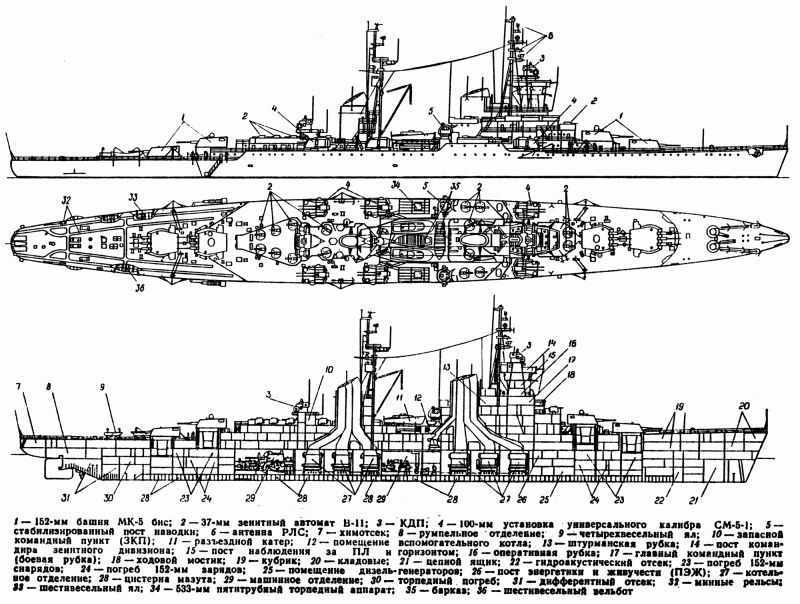
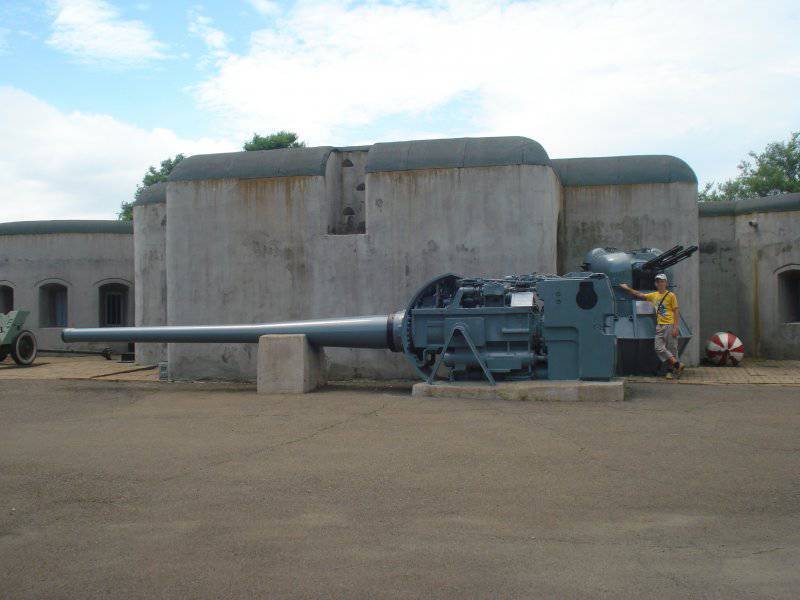
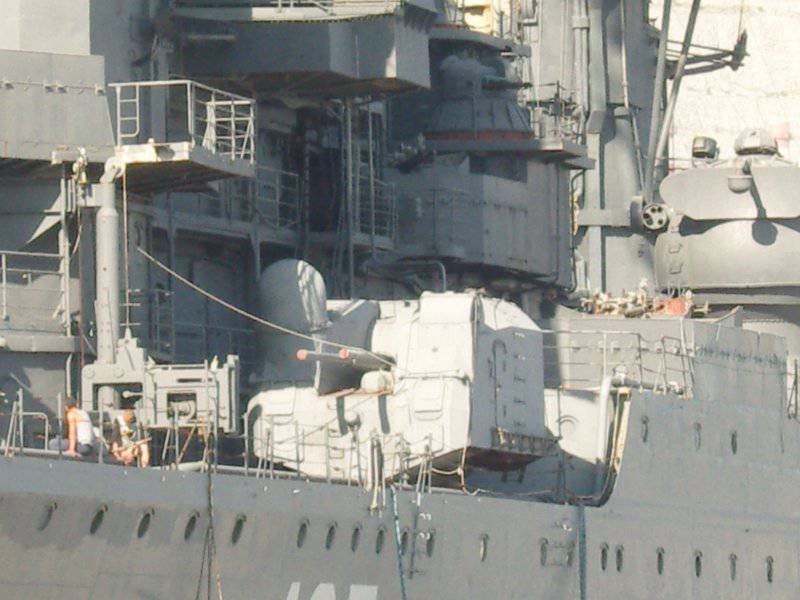
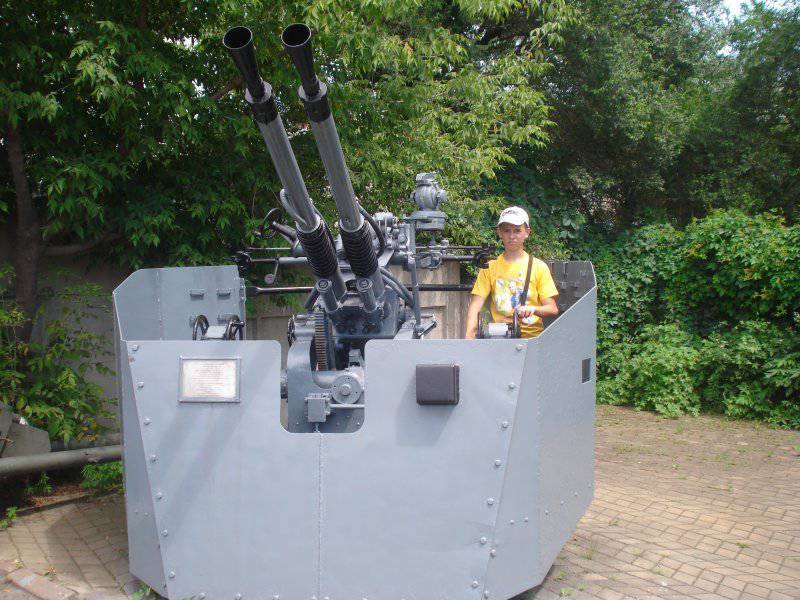
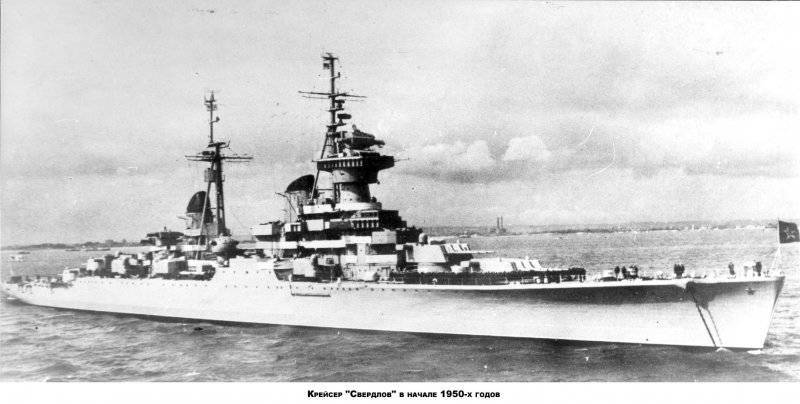
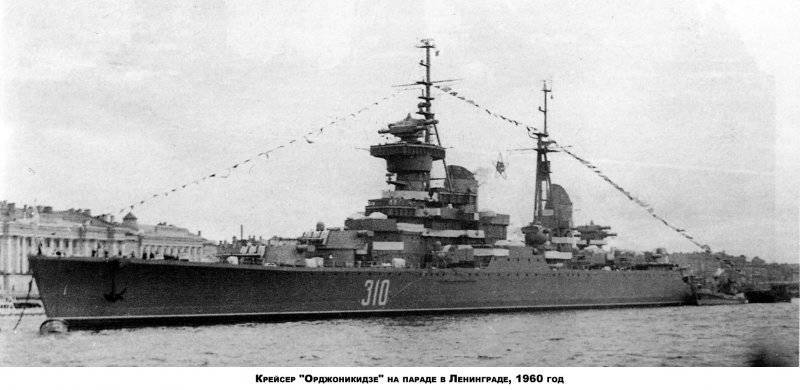
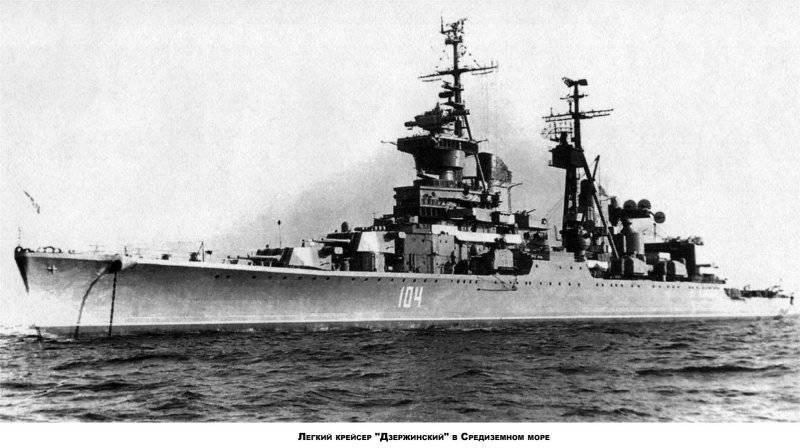
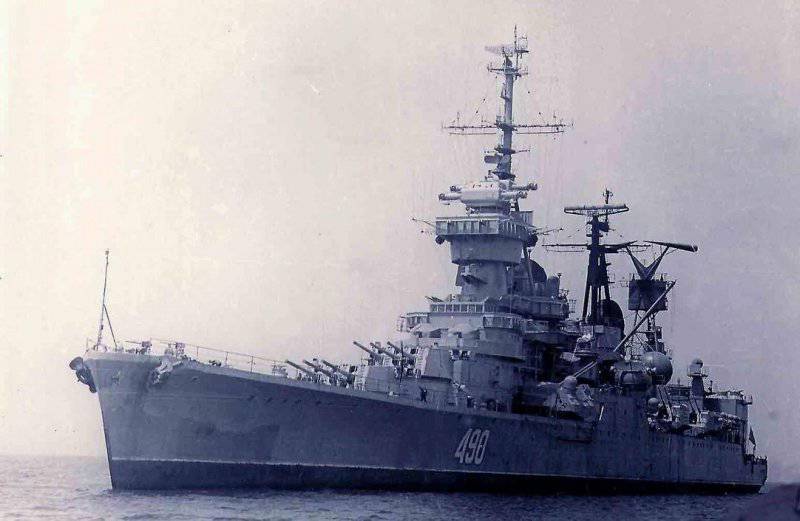
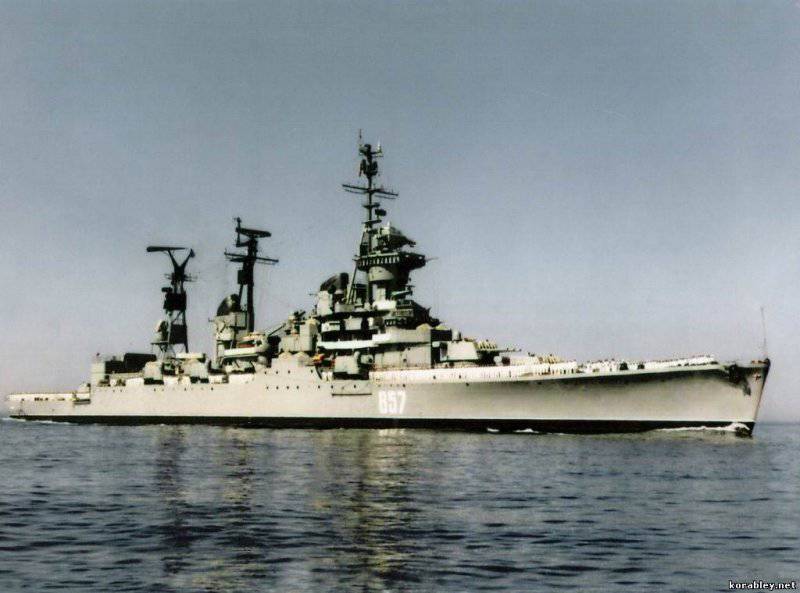
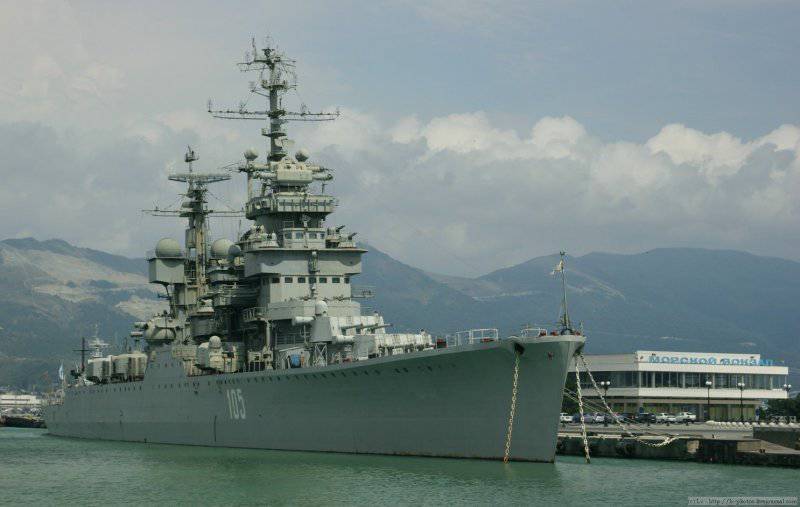
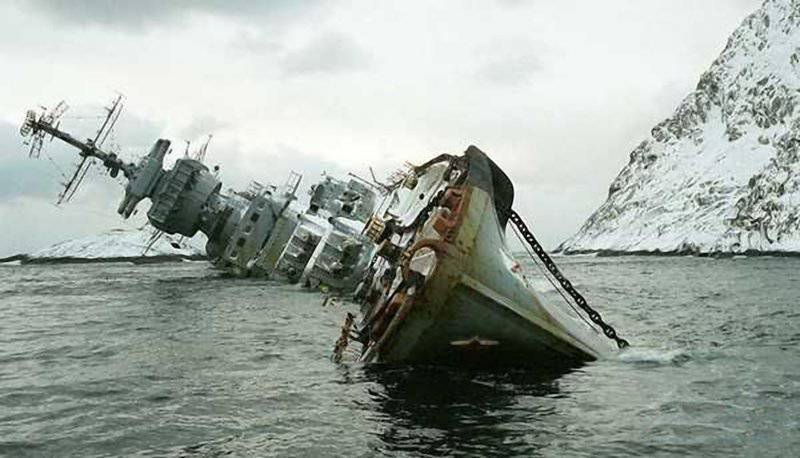
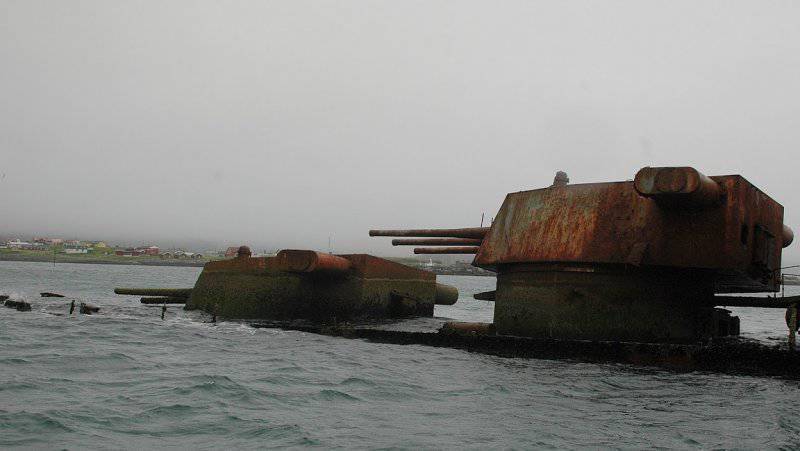
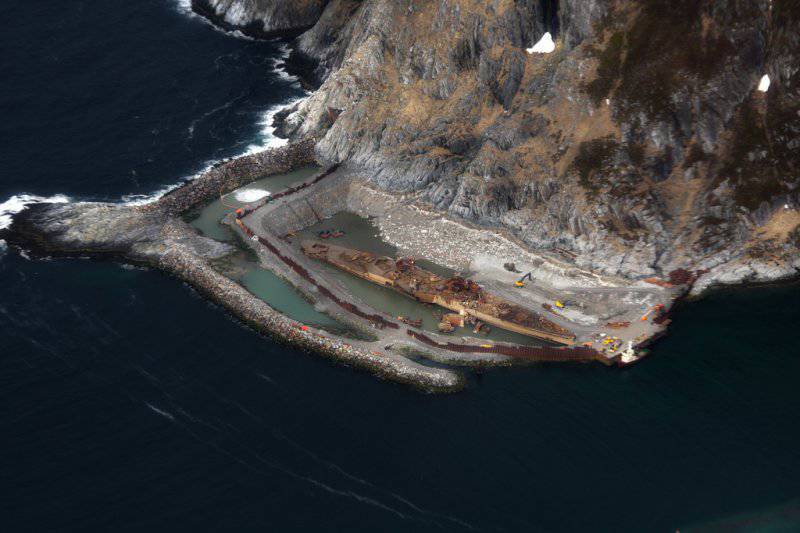
Information